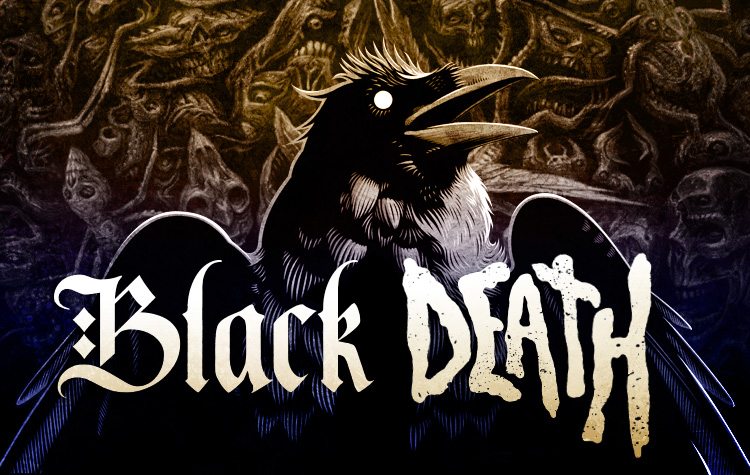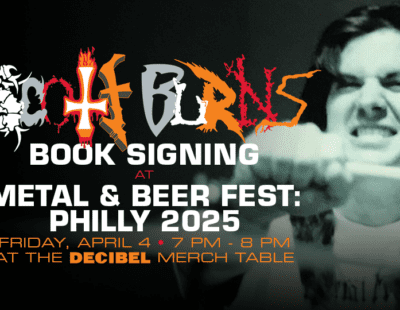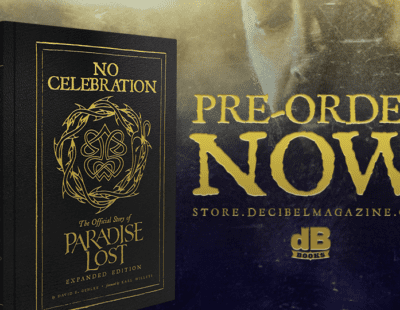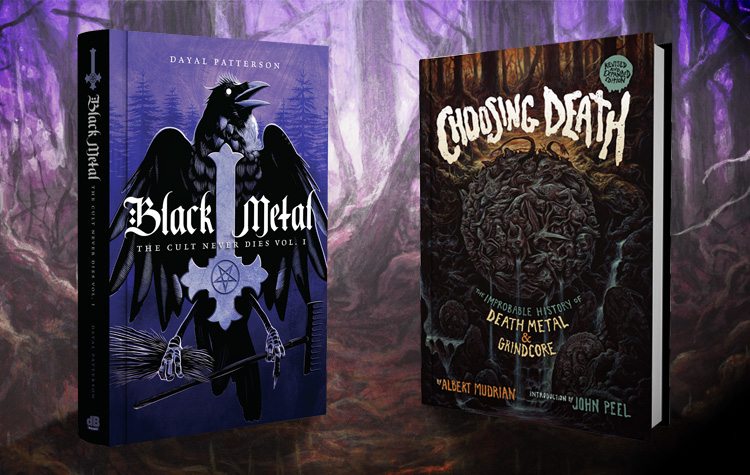
In April 2015, Decibel Books was forged with the release of the revised and expanded edition of of my book Choosing Death: The Improbable History of Death Metal & Grindcore. Later this month, Decibel Books’ second release arrives via Black Metal: The Cult Never Dies Vol. 1 (pre-order here), by British author Dayal Patterson. At some point last year, I thought it might be fun for Dayal and I to interview each other about our respective works. This following is the best of a looooooong email chain between the two of us.
DAYAL PATTERSON: Twelve years ago you released what is surely the best known and most respected book on the death metal genre, Choosing Death. Now, over a decade later, the book is back after undergoing a considerable makeover—so for those who have yet to check the new edition out, what has changed and why?
ALBERT MUDRIAN: At the risk of sounding unsatisfied with the original version of Choosing Death, there were definitely things I wanted to change about the book from the day I received a finished copy—mostly typos, but a couple glaring factual inaccuracies that made me wince for the better part of decade. That wouldn’t have been enough to demand a revision on its own—at least in the eyes of the original publisher—but the next 11 years of death and grind history that followed necessitated an updated book. I feel that the story arc from where things ended with the original in 2003 to where things stood in 2014, when this version was complete, had changed so dramatically (and dare I say, um, improbably) that an updated Choosing Death was more than justifiable.
So, in addition to the aforementioned corrections, what you have in this version are three additional chapters (two covering 2004 through 2014, and another tracing the origins of the Finnish and Dutch scenes), numerous expanded sections in the book’s 10 original chapters, a complete redesign and new cover art from the legendary Dan Seagrave all housed in a hand-numbed hardcover package limited to 3,000 copies. Obviously, a lot of people who bought the book in 2004 will likely consider purchasing this version as well, so every effort was made to ensure that they’d be satisfied with reinvesting in Choosing Death 12 years later.
Rather than wait a decade like myself, you chose to append your genre history, the must-read Black Metal: Evolution of the Cult, only two years later with The Cult Never Dies: Volume 1. Most fans of extreme metal are aware of the former, so please tell them a little more about what drove you to write the latter.
PATTERSON: For me, Evolution was kind of a foundation for the story of black metal. It’s an exploration of how the genre was born and developed into what we know today and so inevitably it focused on the eighties and nineties and on those bands who had created a large impact in terms of influence (as well as those that illustrated specific faces of the genre – industrial black metal, folk black metal and so on). About half way through writing that book I hooked up with a publisher and they of course gave me a maximum word count to work with, so fairly early on it became clear that I would have to be quite selective with the bands I was choosing to feature. That left a huge number of groups and scenes that I felt deserved the same in-depth, one-band-per-chapter approach, so really I view both these books – as well as the ones that will eventually follow – as being part of one big project. And to be honest, some of the bands that were involved this time around would probably have featured in Evolution if I’d had more interview material, the most obvious example being Satyricon, who were mentioned briefly in the first book but give what might be their biggest interview to date in Black Metal: The Cult Never Dies Vol. 1.
You were coming back to your book project after a considerably longer period of time and in those intervening ten years you’ve remained immersed in metal culture and journalism – how was it working with, and adding to, text you’d written a decade ago? Did you find that your writing style and voice had evolved a lot in those intervening years?
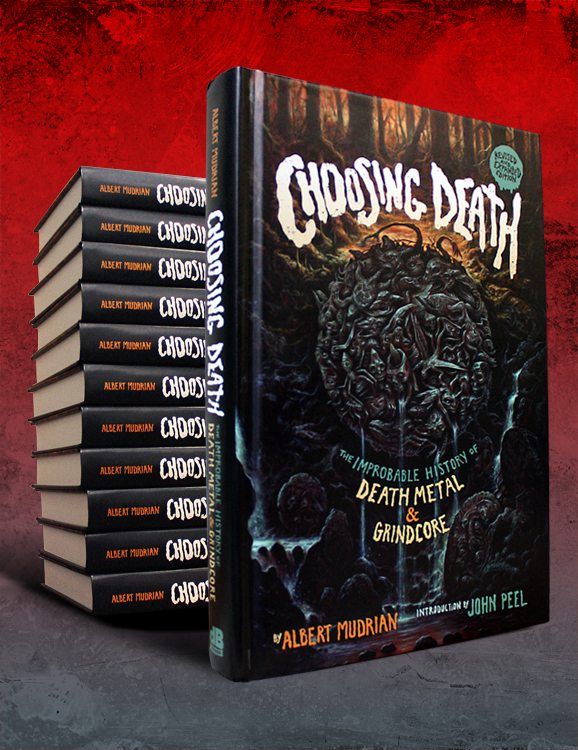
MUDRIAN: It was definitely strange at first, especially in terms of finding good points of re-entry in terms of the existing narrative. As you say, my full-time job running Decibel since 2004 has kept me deeply involved in extreme music, and my general fandom for death and grind, in particular, means I’ve kept close tabs on the evolution of the movements, so that was advantageous. As far as a writing style is concerned, sure, I’ve evolved, but more in terms of tone than style. The way I write in Decibel is my natural voice, which never seemed like the best fit for Choosing Death. Even when I started work on the book in 2002, I made en effort to play the narrative “straight,” so to speak—especially when compared with Decibel, which is never afraid to take an irreverent approach to its subject matter. Obviously, that would be jarring in the context of Choosing Death.
Far more interesting was how many of the artists I interviewed 12 years ago evolved in the intervening years. Some of them—like Carcass’s Jeff Walker—were completely out of the music scene at the time, and were shocked that anyone even cared enough to write a book chronicling the formative days of their band. Today, Carcass are one of the biggest bands in the genres, so obviously that’s going to dramatically change an artist’s—and an author’s—perspective. Reading the book from cover to cover now, you can actually see that evolution in those perspectives, which I’m guessing isn’t something you’ll get from most music history books.
Another advantage was that Choosing Death was obviously an established title, so when I approached people for interviews for the revised and expanded edition, they pretty much knew what they were getting into, and what the book was all about, which was a welcome change from the original version! What was your experience like approaching black metal artists for new interviews after the release of Black Metal: Evolution of the Cult? While the book has garnered almost universal praise in reviews, surely some artists could differ with opinions you expressed on their music.

PATTERSON: I actually had quite a similar experience in terms of approaching people for the sequel. Getting musicians involved in the first book often took quite a lot of explanation because the concept for the whole thing was fairly unique and frankly there was a lot of suspicion around the idea of documenting the history of black metal due to the poor reception of a lot of the books and films that were made in the past. I didn’t necessarily know that it was going to be the case, but Evolution not only seems to convince the reviewers, it really seemed to convince the vast majority of protagonists that I encountered in the scene.
The result was that Black Metal: The Cult Never Dies Volume 1 was much, much easier to make happen because people knew what to expect and had in many cases encountered the first book and enjoyed it. Just as importantly, I think the people who took part were more confident that the project would actually see completion – I think bands are often approached for interviews by books, fanzines and web sites that never come to fruition, so if you’re not working for an established publication there can be some concerns in that regard.
So far there haven’t really been any bad reactions to the books from the bands involved, but that might be partly because there is generally a collaborative process taking place after the main interview to make sure no glaring errors creep in. What about you? Was the reaction from all the people involved positive first time around? And was there anything in particular that you removed or changed for this edition that had been bothering you?
MUDRIAN: While I didn’t have the same collaborative experience as you, I think I had an advantage in that there really wasn’t an air of suspicion around my interest in the death metal and grind scenes. Since that infamous Kerrang! cover story in 1993, the black metal community has been pretty guarded about letting journalists in for fear of being exploited—a general stance that Lords of Chaos only intensified. When it came to chronicling the histories of death metal and grindcore, it was revealed time and time again that most of the people I interviewed were surprised anyone cared enough to even put this story down on paper.
Regarding the reaction to the finished book, more than anything, there was a lot of time spent hanging out over drinks with these band members, inevitably leading to one of them blurting out, “I can’t believe I never told you about the time we [insert salacious, crazy story here].” I’ve stayed friends with many of these artists over the years and worked with almost all of them in one manner or another through Decibel. So, there were countless mental notes I managed to take over the 10-year period between when the original book was published and when the revisions began in earnest. So, I was able to ring Barney Greenway and say, “tell me again how you were stoned when you tracked the vocals for Harmony Corruption.” Or I could phone Jeff Walker and say, “let’s hear all of those insane stories again from the 1990 U.S. tour you did with Death and Pestilence.”
Of course, these guys are human, so a few of them expressed to me that they thought I spent a little too much on Band X or that I gave Band Y too much credit for developing part of the scene. But this criticism could easily come from any reader. Getting back to the aforementioned Lords of Chaos, what are your unfettered feelings about that book? Tell me and maybe I’ll let you know how I really feel about Swedish Death Metal!
PATTERSON: As you suggest Lords of Chaos was met with a huge backlash from the black metal scene when it was released and I’m not going to lie, its existence made writing Evolution a much harder task because a lot of bands were concerned that my book would take a similar approach – in fact, I lost count of the amount of people who asked ‘It’s not going to be like Lords of Chaos is it?’
I think the thing to keep in mind with Lords of Chaos is that isn’t really a book about black metal music or culture as much as it is a “true crime” style book (and was apparently intended to be thus) about murder, church burning, nazis/racism and Satanism/occultism that ends up overlapping with a lot of early ’90s black metal related subject matter. It’s obviously associated strongly with the genre because it was the first book released on the subject but it’s curious that it’s still considered a black metal book bearing in mind that about one third of it is not related to black metal at all – in fact even the title is named after a group of American schoolboys that killed their teacher, with no black metal link and if I remember right, no link to metal period. And a lot of the remaining pages are of course dedicated to the story of Burzum and Mayhem.
What do I think about it? I think it’s a somewhat flawed but often interesting read. There’s some engaging ideas and some good interviews in there but it’s also unfortunately presents a rather distorted picture of black metal. It only focuses on the more controversial aspects of the early to mid nineties scene and a lot of statements made by the bands were essentially posturing for the benefit of an outsider and so it became something like a caricature. I think it’s also a reminder of a brief and slightly unfortunate period when certain types of people (quite often from the industrial/neo-folk scene it must be said) began taking an interest in black metal, not because of the music but mainly due to a fascination with transgressive subjects such as church burning, Varg Vikernes and NSBM. A lot of those characters seemed kind of fixated on the most sensationalist face of the genre and because they often had lot of pre-existing interests with crime, Nazis, supremacists and so on, that’s what they saw black metal to be all about. And of course those things were and are a part of black metal but still, it’s only a piece of a much bigger picture and I think fundamentally the people who were primarily interested in those things often lacked the empathy, interest and understanding to relate to black metal and its protagonists as a whole and so they kind of misconstrued the whole thing. I have to say I don’t see those sort of people in the scene so much these days at shows and so on, I think they probably moved onto other things.
But yeah, back to the book—you can’t write the book off altogether to be sure and especially at the time there was a lot of new material. And I don’t see it as competition or anything like that because there’s actually a very minimal overlap in subject matter. So you can own both books happily—as I do!
So, now tell me what your thoughts are on Swedish Death Metal and the other death metal books out there!
MUDRIAN: Sorry if that was a bit of a tease, but my relationship with Swedish Death Metal is uncomplicated; I totally love it! In fact, I vividly remember getting an email from author Daniel Ekeroth while I was on European holiday in the spring of 2004 (a few months before the original Choosing Death was to be released) where he explained that he was about to start working on the book. Back then, I only knew him as “a guy from Insision,” but it was still really cool to know that someone else was likely going through a similarly excruciating experience, penning a book about death metal—albeit from the perspective of someone who was actually an active part of the scene/movement. About three years later, I contacted Daniel and ordered a copy of Swedish Death Metal directly from him, which cost over $70 U.S. with shipping! Well worth it though, obviously. I’m not exaggerating when I say I spent the better part of next six months downloading demos of bands featured in the book’s exhaustive “A to Z of Swedish Death Metal Bands” appendix. I mean, most of them were shit, but there were a few diamonds in the rough, like Evocation, who I really dug and am rocking right fucking now. I met Daniel a couple years later at Maryland Deathfest and he’s brightened my festival experience every year since. Dude is truly one of a kind.
As far as other books about death metal are concerned, I only know of/own three: Jason Netheron’s recently released Extremity Retained, Alan Moses and Brian Pattison’s Glorious Times and Nicola Costantini’s Encyclopedia of Svensk Dödsmetall. The first of which is full of such rad little tidbits about death metal’s embryonic years, that it’s become a bathroom staple in my home—much to my wife’s dismay. The second is a collection of stories and unreal photos from the late ’80s death metal scene written by the bands themselves, which desperately needs to find its way back in print, as these images really need to be preserved forever. The third is much like a 200-page zine (right down to the design) devoted to Swedish death metal from ’88 to ’92. I think I paid $60 to $70 for this as well. I highly doubt it’s still in print, but if you can track one down, it’s a complete time warp of shitty band pics and even shittier type set but I can’t get enough of it!
So, while I’ll go on record as saying I don’t need to read any more books about black metal unless you are writing them, I’m more than excited to read any additional books about death metal, a long as I am not writing them! On the topic of that, have you started work on another volume of The Cult Never Dies? If so, are you willing divulge any of the artists/subgenres you intend to cover?
PATTERSON: I have indeed, although some of what I’m doing at the moment may end up somewhere else rather than Black Metal: The Cult Never Dies Vol. 2, it’s a bit early to say. However, I can confirm that I will be covering the Greek scene in the next volume and quite a lot of work has already gone into telling that story properly, looking at bands such as Necromantia, Thou Art Lord, Varathron, Agatus, Zemial and so on. Hopefully there will be some more original photography involved for this book as well. I’m also working on explorations of Sweden, America, Finland and some other places, but as I say it’s not entirely clear how the finished work will be organised.
Just to make things a bit more complicated, I am releasing a work called Black Metal: Into the Abyss which is a work that expands the series a little but working in a looser format, with some fanzine characteristics. It mainly leans toward newer bands (with a few exceptions) and is a kind of sidestep from Black Metal: The Cult Never Dies Volume 1, and is mainly dealing with similar subject matter, i.e. Norway and Poland. Some of the bands involved include; Vemod, One Tail, One Head, Massemord, Furia, Tsjuder, Koldbrann, and I think it is going to make for really good reading – still continuing the black metal story, but taking a break from the format of the first two books to offer some different perspectives.
